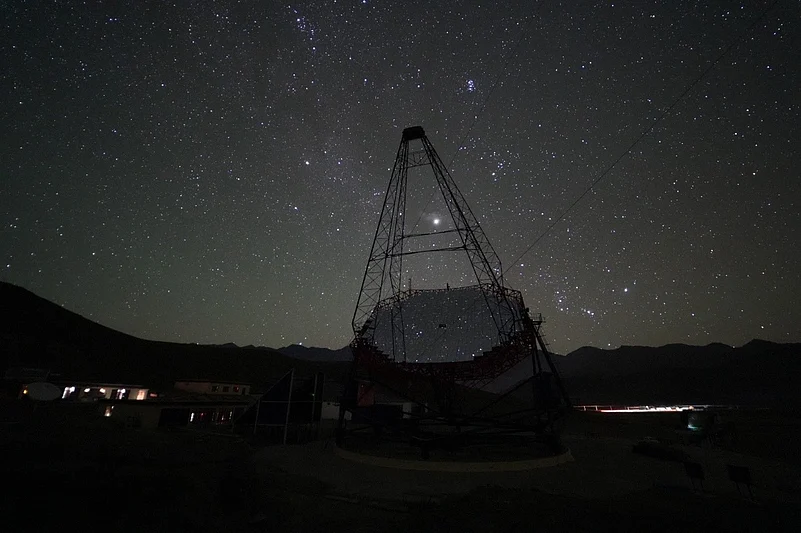The Major Atmospheric Cherenkov Experiment (MACE) observatory, Asia's largest imaging Cherenkov telescope, was recently inaugurated in Hanle, Ladakh. Developed by the Bhabha Atomic Research Centre (BARC), this cutting-edge telescope will greatly enhance scientific research in the region by studying high-energy cosmic rays and gamma rays.
Asia's Largest Imaging Telescope Launched In Ladakh
The MACE telescope is designed to study gamma rays using the Cherenkov imaging technique, which detects the faint light produced when high-energy particles interact with the Earth's atmosphere.

Positioned at an altitude of 4,300 meters, it holds the distinction of being the highest telescope of its kind in the world. Its high-altitude location offers clearer observations of cosmic events, such as supernovae and black holes, due to the thin atmosphere and low light pollution.
The MACE observatory was inaugurated on October 4, 2024, by Ajit Kumar Mohanty, Secretary of the Department of Atomic Energy (DAE) and Chairman of the Atomic Energy Commission, as part of the platinum jubilee year celebrations of the DAE. The telescope was indigenously developed by BARC in Mumbai, with significant contributions from Electronics Corporation of India Ltd (ECIL) and various other Indian industrial partners.
In his inaugural speech, Mohanty praised the collective efforts of all parties involved in making the MACE project a reality. He highlighted the importance of this observatory as a major milestone for India in cosmic-ray research and said that it would propel the nation to the forefront of high-energy gamma-ray studies. These gamma rays are some of the most energetic events in the universe, and understanding them will deepen our knowledge of cosmic phenomena.
The MACE telescope is designed to study gamma rays using the Cherenkov imaging technique, which detects the faint light produced when high-energy particles interact with the Earth's atmosphere. This capability allows scientists to explore extreme cosmic events, such as supernovae, black holes, and other high-energy phenomena that are otherwise difficult to observe.
Mohanty also pointed out the observatory’s dual role in benefiting both scientific research and the socio-economic development of Ladakh. By establishing such a sophisticated facility in the region, opportunities for scientific collaboration, education, and employment will increase, contributing to the overall growth of the area.
In addition to the MACE observatory, Ladakh is home to several other prominent telescopes and observatories, with a solid reputation as a hub for astronomical research. The Indian Astronomical Observatory (IAO) in Hanle is one of the highest observatories in the world and is home to the 2-meter Himalayan Chandra Telescope, which has played a key role in global research in optical and infrared astronomy. Ladakh will also host LIGO-India, a major gravitational-wave observatory that is part of a global network aimed at detecting cosmic events like black hole mergers. These facilities, along with atmospheric monitoring stations, take advantage of Ladakh's clear skies and low light pollution, making the region perfect for space and atmospheric research.
The MACE observatory is expected to attract global attention in the field of astrophysics and cosmic-ray studies, solidifying India’s position as a key player in space and atmospheric research. The project shows India's ability to create and manage advanced scientific facilities and marks a major step forward in understanding the universe's mysteries.
(This article is reworked version of a PTI feed)
- Previous Story
 UNIFIL In Crossfire: Rising Tensions In Southern Lebanon Amid Israel-Hezbollah Conflict
UNIFIL In Crossfire: Rising Tensions In Southern Lebanon Amid Israel-Hezbollah Conflict - Next Story






















